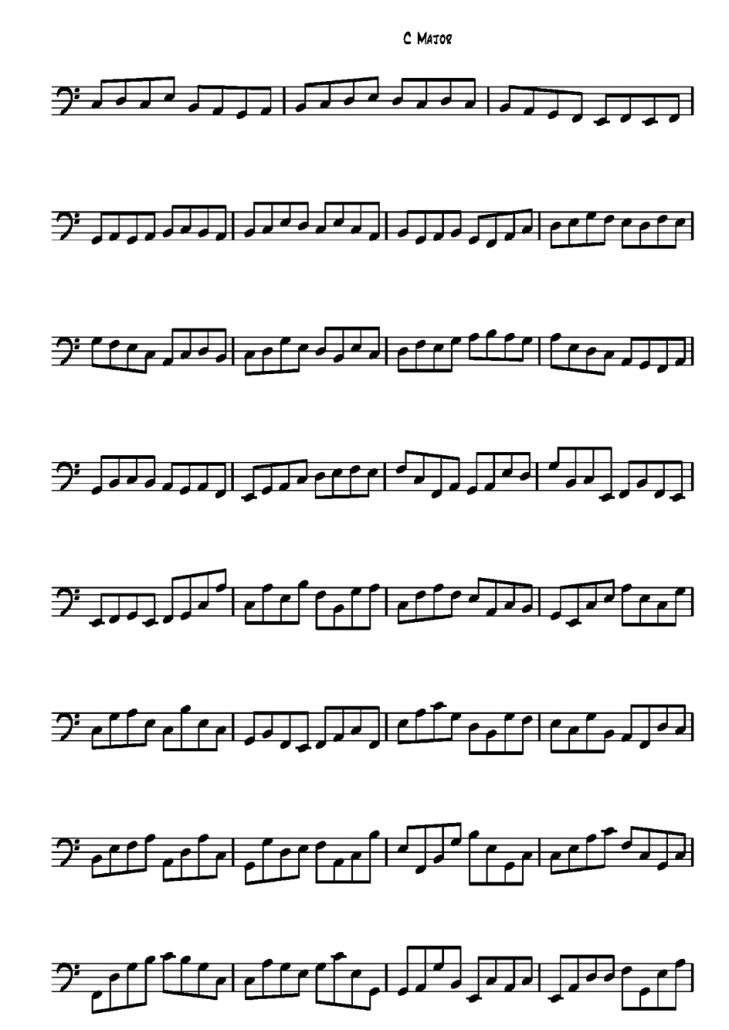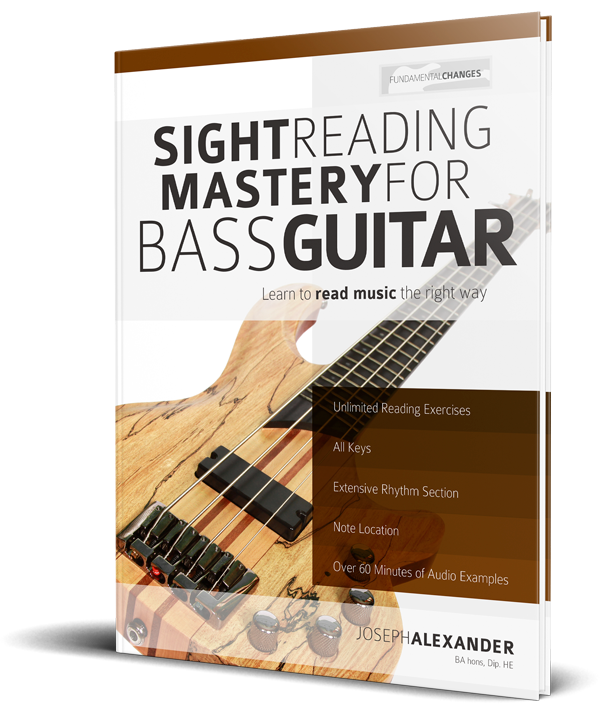Sight Reading on Bass Guitar – Master it now!
Sight reading on Bass Guitar is a challenging topic.
When we read a word on paper, our brain is recognising a pattern and attaching meaning to it. This is the process you began learning when you were a few years old. To master sight reading on bass guitar, we need to first of all recognise the dots and lines of music notation as easily as you are reading these words now. We simply need to attach meaning to new patterns.
Music notation works by giving an almost graphical view of pitch against time. As you read from left to right, you could consider this as time moving forward as a constant pace (governed by tempo). The height of the note on the stave (the five horizontal lines) tells us its pitch.
Each line and space is a set, consistent note which will always sound at the same pitch. Here are the notes from the C Major scale with their letter names written in below.
Sight Reading on Bass Guitar example 1
This can be a lot to take in at first, so it can be easier to separate the notes on the lines from the notes in the spaces:
Sight Reading on Bass Guitar example 2
The notes in the spaces are A, C, E and G. You can remember this as
All Cows Eat Grass
The notes that lie on the lines are G, B, D, F and A, which spell out:
Grizzly Bears Don’t Fly Airplanes
There are plenty of phrases you can use to remember these notes so try coming up with your own.
Sight Reading on Bass Guitar example 3
Keep referring to the names previously written if you struggle to remember them.
Look at the following example and (without your bass) read along the top line of the page. Say each note out loud as you read it. This will reinforce the mental link between the note and your recognition.
Sight Reading on Bass Guitar example
This will take some time and effort at first so it is OK to go very slowly. When I was learning to read music to a high level I frequently felt disorientated and hungry when I’d finished, such was the effort it took!
Avoid constantly re-reading the same pieces of music as you’ll eventually end up memorising the passage which isn’t helpful.
If you feel ready to move onto the second lines of the big example above feel free, however you can get four times the benefit from any line in this lesson by trying the following ideas:
- Read it forwards
- Read it backwards
- Turn the page upside down and read it forwards
- Turn the page upside down and read it backwards
Try reading through the notes of the example above using the four methods mentioned above. If you feel confident move on to read the next lines. There is no need to go too far at this stage.
When you’re gaining confidence, set a metronome to 40 beats per minute and say the notes out loud in time with the click. You should be reading two notes for every click of the metronome. Over the period of a few days gradually increase the metronome speed in increments of 5 beats per minute (bpm) to 60 or above.
All of this should occur without your instrument in your hands. We’re just trying to memorise the meaning of each dot. You could imagine you’re an actor in a play and you’re trying to memorise your words without the distraction of actually having to perform them at the same time.
Now let’s extend the range of the notes we are reading both above and below the stave:
Sight Reading on Bass Guitar example 4
We have now covered every note that occurs on the large example above.
You can now begin to read all the way through the large example. As this becomes easier, remember to switch things around by using the four points above to create new material.
Now, here is where all the notes in this lesson exist on the bass.
Play through the above examples saying each note out loud.
Set the metronome back to 40bpm and work in the same way to incrementally increase your note recognition.
Check out part two of this lesson here <LINK TO PART 2> and learn to read sharps and flats on bass guitar
If you want to learn to sight read bass guitar the right way then check out our best-selling book, Sight Reading Mastery for Bass Guitar
“The artists you work with, and the quality of your work speaks for itself.”
Tommy Emmanuel
© Copyright Fundamental Changes Ltd 2024
No.6 The Pound, Ampney Crucis, England, GL7 5SA







